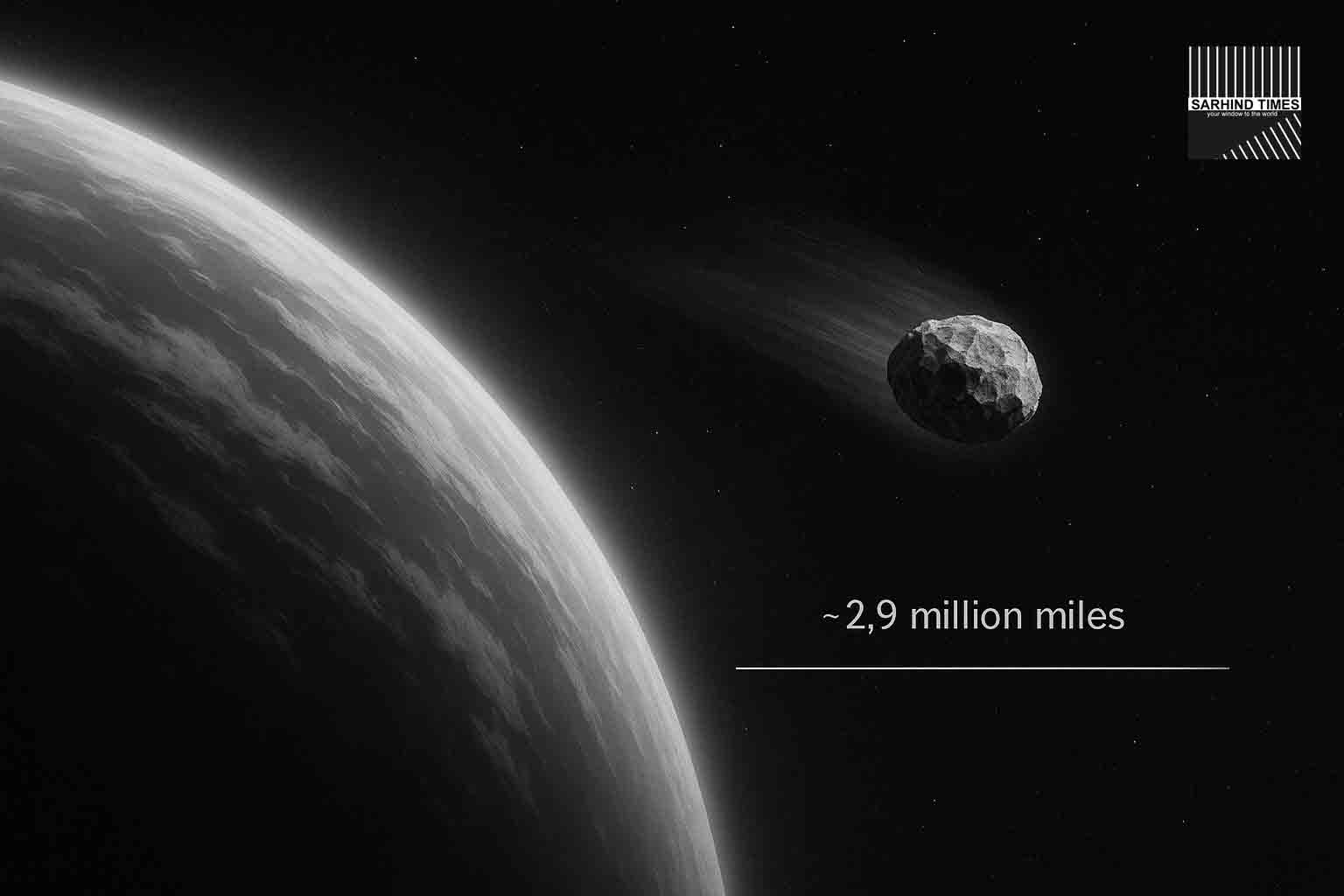By Sarhind Times Science Desk | New Delhi | October 2, 2025
NEW DELHI: A house-sized space rock catalogued as 2025 SY will zip past Earth today at a distance of about 2.9 million miles (≈ 4.67 million km)—“close” in planetary-defence jargon, but nowhere near dangerous, according to tracking data referenced by NASA and reported by Indian media earlier this morning. The object is roughly 14 m (≈ 45 ft) across, travels at about 13,000 mph (≈ 21,000 km/h) relative to Earth, and has no impact risk from this pass. For sky-watchers, it’s a faint target; for scientists, it’s another opportunity to refine orbits and test alert pipelines without public alarm.
What often gets lost in the social-media churn around “asteroid alerts” is the quiet, routine part of this story: NASA’s Planetary Defense Coordination Office (PDCO) and the Center for Near-Earth Object Studies (CNEOS) monitor thousands of near-Earth objects daily, publish monthly tallies, and flag only those that warrant extra attention. As of mid-September, the discovered NEO count stands above 39,000, including 11,000+ larger than 140 m, with constant updates as surveys scan the sky.
What’s actually happening today
- Object: Near-Earth asteroid 2025 SY (estimated diameter ~14 m).
- Closest approach: ~2.9 million miles (≈ 4.67 million km)—about 12 lunar distances—today.
- Relative speed: ~13,158 mph (≈ 21,176 km/h).
- Risk: None from this flyby; no impact probability is indicated.
For context, NASA classifies an asteroid as potentially hazardous only if both of the following are true: its Earth-approach geometry brings its orbit within 0.05 astronomical units (≈ 7.5 million km) and it is large enough—defined by an absolute magnitude H ≤ 22, which corresponds to roughly ≥ 140 m in size. On those criteria, 2025 SY is far too small to qualify, and its approach distance today remains well outside any threshold of concern.
The takeaway: “Close” does not mean “dangerous.” It means “interesting to track.”
Is 2025 SY an Aten or an Apollo? (And why that label isn’t the safety headline)
Early snippets circulating online described 2025 SY as an Aten-group asteroid (a class whose semi-major axis is < 1 AU and aphelion > 0.983 AU), but JPL’s Small-Body Database Browser currently lists 2025 SY as an Apollo-class near-Earth asteroid—the other large family of Earth-crossers (semi-major axis > 1 AU). Catalogs update as additional observations refine an orbit, and either label—Aten or Apollo—simply tells astronomers the shape and size of the orbit, not whether the object is dangerous. The hazard question is governed by the size (H-magnitude) and the minimum orbit intersection distance (MOID), not by whether it’s in the Aten or Apollo bucket.
Why this flyby is routine—and useful
- Pipeline practice. When small NEOs pass nearby, CNEOS and global networks use the moment to cross-check models, timing, and alert pathways. It’s a live drill for the system, without the stakes of a real threat.
- Orbit refinement. Every new observation trims uncertainties. Tiny shifts can matter over decades as gravitational nudges accumulate.
- Public literacy. “Close approaches” happen frequently. Turning them into teachable moments demystifies planetary defence and guards against alarmist misinformation online.
How close is “close”? Decoding the numbers
- 2.9 million miles is about 4.67 million km or roughly 12.1 lunar distances—a far cry from the Moon’s orbit (1 LD) and even farther from any atmospheric grazing scenario.
- NASA’s potentially hazardous distance test uses MOID ≤ 0.05 AU, which equals about 7.5 million km (~4.66 million miles). But MOID is a property of the orbit, not a one-day snapshot, and must be paired with size (H ≤ 22) to earn the “PHA” tag. 2025 SY is far smaller than that size threshold.
What we can and can’t see from India tonight
Let’s set expectations. A ~14-metre rock at ~12 LD will be far too dim for the naked eye and a stretch for casual binoculars. Mid-sized amateur telescopes under dark skies could attempt time-boxed imaging if they have accurate ephemerides and a tracking workflow that accommodates the object’s apparent motion. The professional way to plan those attempts is to query JPL’s Horizons system for an observing site and time window, then plug the output into a planetarium app. Casual viewers are better off enjoying the knowledge that a small, harmless space rock just flew by, and that the global warning system noticed it—exactly as designed.
For the public, NASA’s Eyes on Asteroids offers a 3D visualization of close approaches. You can explore flyby geometry, scale, and speed with interactive controls—no telescope required.
Planetary defence 101—what counts as a worry?
- Size matters most. NASA’s working PHA size proxy (H ≤ 22) translates to roughly ≥ 140 m across—large enough to cause regional damage if it hit land or a serious tsunami if it hit ocean. Smaller objects—like 2025 SY at ~14 m—burn up or explode at high altitude, often with fireball phenomena but limited ground damage.
- Geometry matters next. An orbit that can intersect Earth’s at the wrong time raises flags. NASA uses MOID to gauge how closely two orbits can approach, then applies risk scales (Torino/Palermo) to characterize likelihood and consequence.
- Time horizons are long. The risk question is often about decades ahead. That’s why accurate orbits and steady observation arcs are crucial—and why “close approaches” that aren’t hazardous still matter for science and safety preparedness.
Sorting fact from fluff: three things to ignore when you see “asteroid alert” posts
- “It’s close, so it’s dangerous.” False. “Close” in space is often millions of kilometres. Today’s pass is ~12 LD—many times the Earth–Moon distance.
- “It’s Aten/Apollo, so panic.” False. Aten/Apollo labels describe orbital class, not threat. The hazard call depends on size + MOID + probability.
- “Hazard threshold is 85 m.” Not NASA’s standard. The PHA criterion is H ≤ 22 (~≥ 140 m) and MOID ≤ 0.05 AU. 2025 SY is well below that size.
How NASA (and the world) keep watch
- Discovery surveys: Pan-STARRS, ATLAS, Catalina Sky Survey, and a growing roster of global observatories feed detections to the Minor Planet Center; orbits are refined at JPL CNEOS/SBDB and others. (The SBDB entry for 2025 SY is already live and will continue to update as observations accumulate.)
- Monthly public dashboards: NASA PDCO publishes NEO counts and highlights—a transparent scoreboard of what we’ve found and what remains.
- Public tools: Eyes on Asteroids (visualization) and Horizons (precision ephemerides) let journalists, students, and advanced amateurs do hands-on verification.
Q&A: the questions our readers ask most
Will we be able to see it in Delhi/Mumbai tonight?
No—too faint for the naked eye. A mid-sized telescope with precise tracking and the right timing might record it as a faint point. Use JPL Horizons for exact coordinates if you know your mount and workflow.
If it’s not hazardous, why alert at all?
Because transparency builds trust. Also, every pass helps tighten orbits and exercise the alert system without drama.
What if its path changes suddenly?
Orbits are continuously refined as new observations come in. For such a small object at this distance, the impact probability is effectively zero today; significant updates would appear on CNEOS and MPC listings.
Is this the same as the “skyscraper-sized” asteroid we read about last month?
No. That was 2025 FA22, a far larger object that passed safely at ~4.6 million miles. Today’s visitor is much smaller and also safe.
How close approaches become stories: a reporter’s checklist
When you see a viral claim, try this five-step sanity filter:
- Find the object in JPL SBDB (for identity/orbit class) and CNEOS close-approach table (for distance/time). If one pipeline is down momentarily, check again—these are live systems.
- Check the size proxy (H value). If H > 22 (smaller than ≈ 140 m), the object won’t be tagged “PHA” even if geometry is snug.
- Look at the units. LD (lunar distances) and AU (astronomical units) are more intuitive than bare kilometres in headlines.
- Beware “shock adjectives.” “City-killer” is not a scientific category.
- Link to official tools: Eyes on Asteroids for public visualization; Horizons for ephemerides.
Why these flybys matter for India’s science ecosystem
India’s observatories, universities, and amateur astronomy clubs routinely contribute astrometric data and public outreach. Close approaches like 2025 SY are chances to:
- Demonstrate ephemeris use in classroom labs.
- Train on fast-moving targets (useful for tracking satellites, space debris, and NEOs).
- Practice responsible communication: clear graphics, accurate units, and links to primary sources.
India’s rising role in planetary science—through ISRO missions, data analysis, and a vocal amateur community—means public literacy around terms like “MOID,” “H-magnitude,” “LD,” and “Aten/Apollo” will keep improving.
The bigger picture: from DART to the next-gen survey era
The DART mission’s kinetic impact on Dimorphos in 2022 proved that deflection can work in principle. The next leg involves faster discovery (Vera C. Rubin Observatory/LSST), better characterisation (space-based IR telescopes), and rehearsed governance for the day when a real risk emerges. Safe flybys like 2025 SY are the everyday practice that keeps this enterprise sharp.
Bottom line for today
- 2025 SY is small and safe.
- Its closest approach is millions of miles away—“close” for astronomers, irrelevant for risk.
- If you want to see anything, try Eyes on Asteroids; if you want to compute where it is, use JPL Horizons.
#Asteroid #NEO #NASA #CNEOS #PlanetaryDefense #Space #Astronomy #2025SY























+ There are no comments
Add yours